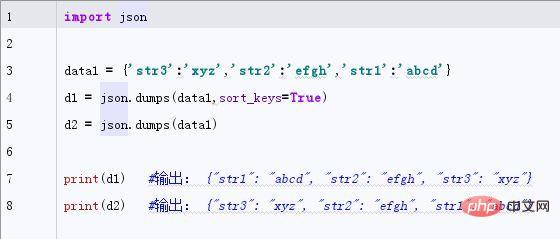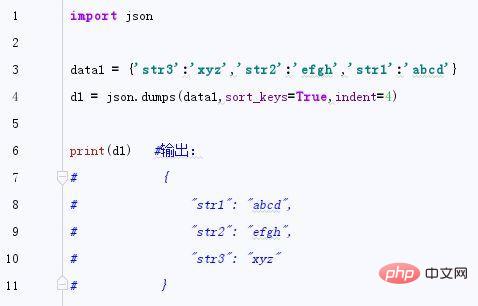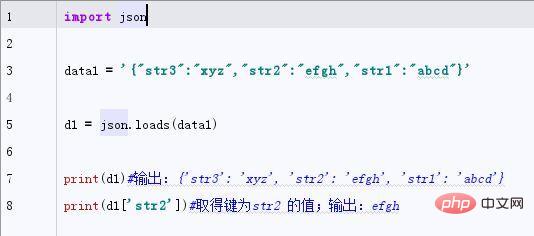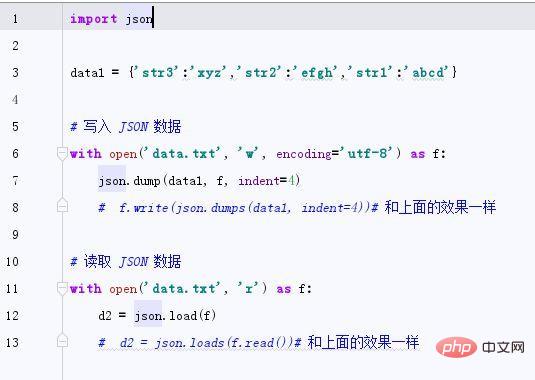How to use python's json
Json (JavaScript Object Notation) is a lightweight data exchange format with many advantages such as simple data format, easy reading and writing, and easy understanding. Many mainstream programming languages are using it for front-end and back-end data transmission, which greatly simplifies the development workload of servers and clients. Compared with XML, it is more lightweight and easier to parse, so many developers follow the Json format for data transmission and exchange. Today we will introduce in detail Python’s knowledge of Json encoding and decoding.

The powerful Python provides a "json" module, which can easily encode various scattered data into a json format data through the built-in function of the module, or you can It is very easy to use to decode a json format data into the data you need. Let’s introduce it below.
json.dumps()
The dumps function in the json module encodes data to form data in json format. Let’s take a look at the following example:

It is easy to see from the output results that the dictionary is converted into json format through the dumps method, although they are very similar. Among them, the parameter "sort_keys=True" in dumps causes the keys and values to be sorted in the order of 0~9 and a~z after outputting json. If not filled in, they will be arranged in disorder. Sometimes, it is convenient to compare data in json by sorting, so appropriate sorting is necessary.
In addition, the "Indent" parameter means indentation, which can make the output Json look neater and more readable, for example:

The following is a list of the fillable parameters of dumps():
skipkey: The default is False, when the data in the dict object is not Python’s basic data type; (str, unicode, int, long, float, bool, None), when skipkey is False, an error will be reported. If skipkey is True, this type of key can be skipped;
indent: If filled in with 0 or not filled in, then Print according to one line, otherwise the preceding space (positive integer form) will be displayed according to the value of indent;
separators: separator, the default is "(',',':')", which means between keys Separated by ",", key and value are separated by ":";
encoding: encoding format, the default value is UTF-8;
sort_keys: sort key and value Sorting, the default value is False, that is, no sorting;
ensure_ascii: The default is True. If the dict object contains none-ASCII characters, the \uXX format will be displayed. If it is False, it will be displayed normally. ;
json.loads()
Contrary to dumps, the loads function decodes the data in json format and converts it into a Python dictionary. Let’s take a look at the following example :

Sometimes, when the output result encounters Chinese, the encoding format will be different, and the Unicode encoding format will be displayed, making it difficult to understand. Solve The way is to add the parameter "encoding" parameter, that is, rewrite the above as follows: d1 = json.loads(data1, encoding='utf-8').
json.dump() and json.load()
Compared with the dumps and loads mentioned above, the dump and load functions have similar functions. However, the former is used to process string types, while the latter is used to process file types, as shown below:

The above example lists four methods of json : Simple usage methods of dumps() and dump(), loads() and load(). It can be seen that Python is quite convenient for processing json, unlike c (whoever uses it knows).
The above is the detailed content of How to use python's json. For more information, please follow other related articles on the PHP Chinese website!

Hot AI Tools

Undresser.AI Undress
AI-powered app for creating realistic nude photos

AI Clothes Remover
Online AI tool for removing clothes from photos.

Undress AI Tool
Undress images for free

Clothoff.io
AI clothes remover

Video Face Swap
Swap faces in any video effortlessly with our completely free AI face swap tool!

Hot Article

Hot Tools

Notepad++7.3.1
Easy-to-use and free code editor

SublimeText3 Chinese version
Chinese version, very easy to use

Zend Studio 13.0.1
Powerful PHP integrated development environment

Dreamweaver CS6
Visual web development tools

SublimeText3 Mac version
God-level code editing software (SublimeText3)

Hot Topics
 1386
1386
 52
52
 Can visual studio code be used in python
Apr 15, 2025 pm 08:18 PM
Can visual studio code be used in python
Apr 15, 2025 pm 08:18 PM
VS Code can be used to write Python and provides many features that make it an ideal tool for developing Python applications. It allows users to: install Python extensions to get functions such as code completion, syntax highlighting, and debugging. Use the debugger to track code step by step, find and fix errors. Integrate Git for version control. Use code formatting tools to maintain code consistency. Use the Linting tool to spot potential problems ahead of time.
 How to run programs in terminal vscode
Apr 15, 2025 pm 06:42 PM
How to run programs in terminal vscode
Apr 15, 2025 pm 06:42 PM
In VS Code, you can run the program in the terminal through the following steps: Prepare the code and open the integrated terminal to ensure that the code directory is consistent with the terminal working directory. Select the run command according to the programming language (such as Python's python your_file_name.py) to check whether it runs successfully and resolve errors. Use the debugger to improve debugging efficiency.
 Can vs code run in Windows 8
Apr 15, 2025 pm 07:24 PM
Can vs code run in Windows 8
Apr 15, 2025 pm 07:24 PM
VS Code can run on Windows 8, but the experience may not be great. First make sure the system has been updated to the latest patch, then download the VS Code installation package that matches the system architecture and install it as prompted. After installation, be aware that some extensions may be incompatible with Windows 8 and need to look for alternative extensions or use newer Windows systems in a virtual machine. Install the necessary extensions to check whether they work properly. Although VS Code is feasible on Windows 8, it is recommended to upgrade to a newer Windows system for a better development experience and security.
 Is the vscode extension malicious?
Apr 15, 2025 pm 07:57 PM
Is the vscode extension malicious?
Apr 15, 2025 pm 07:57 PM
VS Code extensions pose malicious risks, such as hiding malicious code, exploiting vulnerabilities, and masturbating as legitimate extensions. Methods to identify malicious extensions include: checking publishers, reading comments, checking code, and installing with caution. Security measures also include: security awareness, good habits, regular updates and antivirus software.
 What is vscode What is vscode for?
Apr 15, 2025 pm 06:45 PM
What is vscode What is vscode for?
Apr 15, 2025 pm 06:45 PM
VS Code is the full name Visual Studio Code, which is a free and open source cross-platform code editor and development environment developed by Microsoft. It supports a wide range of programming languages and provides syntax highlighting, code automatic completion, code snippets and smart prompts to improve development efficiency. Through a rich extension ecosystem, users can add extensions to specific needs and languages, such as debuggers, code formatting tools, and Git integrations. VS Code also includes an intuitive debugger that helps quickly find and resolve bugs in your code.
 Python: Automation, Scripting, and Task Management
Apr 16, 2025 am 12:14 AM
Python: Automation, Scripting, and Task Management
Apr 16, 2025 am 12:14 AM
Python excels in automation, scripting, and task management. 1) Automation: File backup is realized through standard libraries such as os and shutil. 2) Script writing: Use the psutil library to monitor system resources. 3) Task management: Use the schedule library to schedule tasks. Python's ease of use and rich library support makes it the preferred tool in these areas.
 Can visual studio code run python
Apr 15, 2025 pm 08:00 PM
Can visual studio code run python
Apr 15, 2025 pm 08:00 PM
VS Code not only can run Python, but also provides powerful functions, including: automatically identifying Python files after installing Python extensions, providing functions such as code completion, syntax highlighting, and debugging. Relying on the installed Python environment, extensions act as bridge connection editing and Python environment. The debugging functions include setting breakpoints, step-by-step debugging, viewing variable values, and improving debugging efficiency. The integrated terminal supports running complex commands such as unit testing and package management. Supports extended configuration and enhances features such as code formatting, analysis and version control.
 Can vs code run python
Apr 15, 2025 pm 08:21 PM
Can vs code run python
Apr 15, 2025 pm 08:21 PM
Yes, VS Code can run Python code. To run Python efficiently in VS Code, complete the following steps: Install the Python interpreter and configure environment variables. Install the Python extension in VS Code. Run Python code in VS Code's terminal via the command line. Use VS Code's debugging capabilities and code formatting to improve development efficiency. Adopt good programming habits and use performance analysis tools to optimize code performance.




